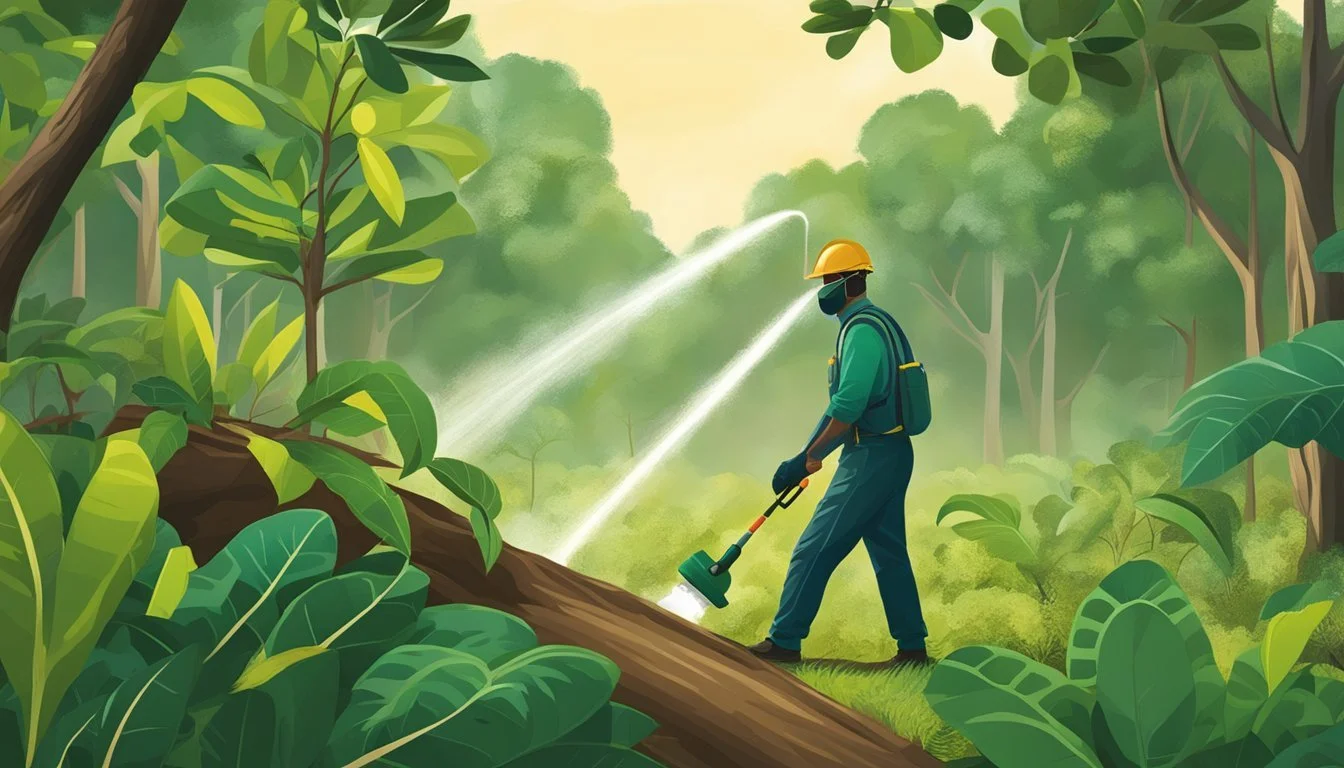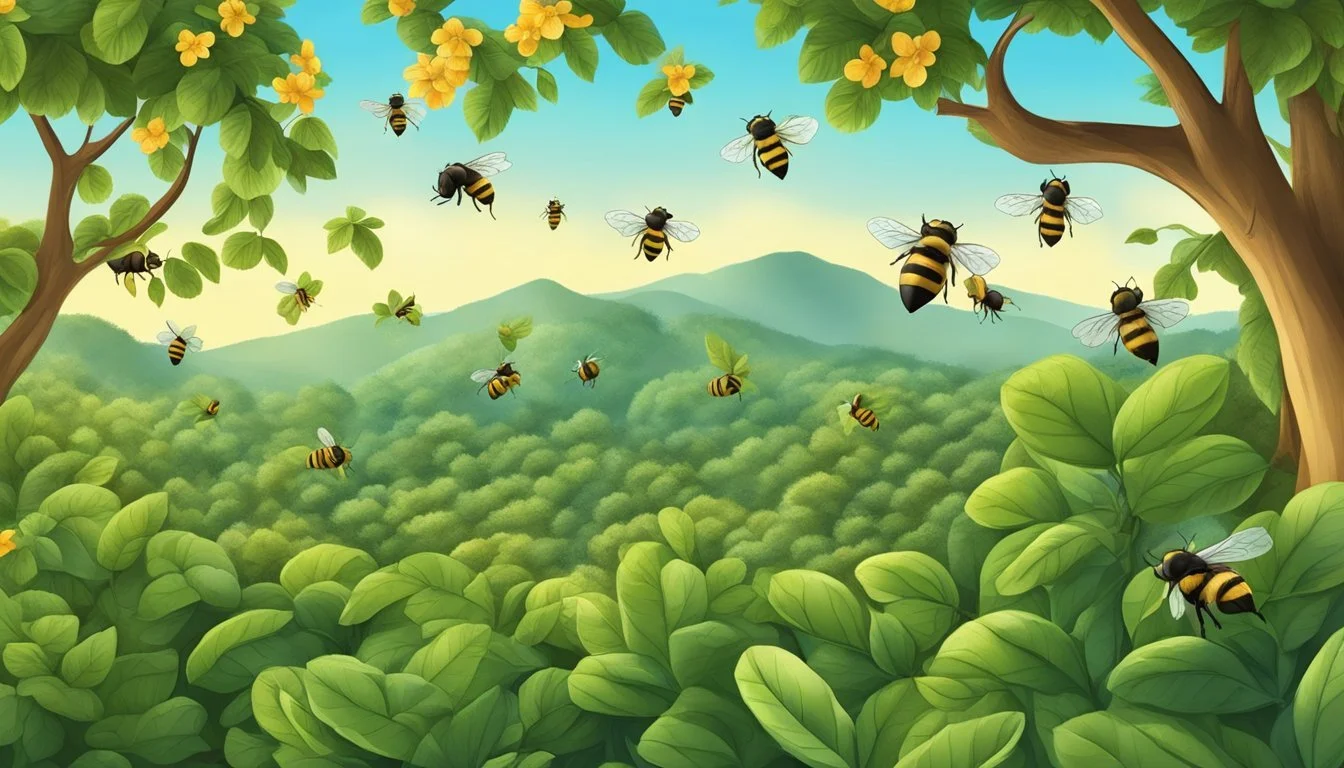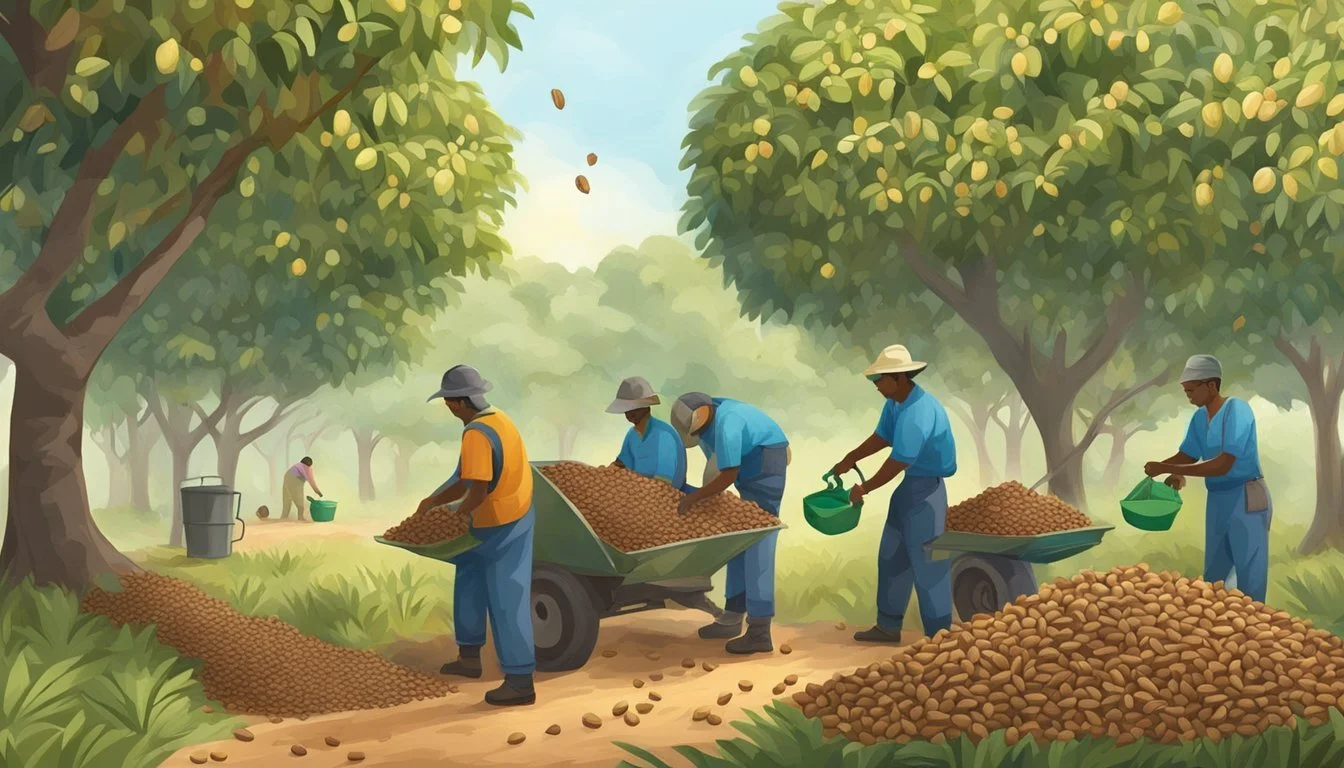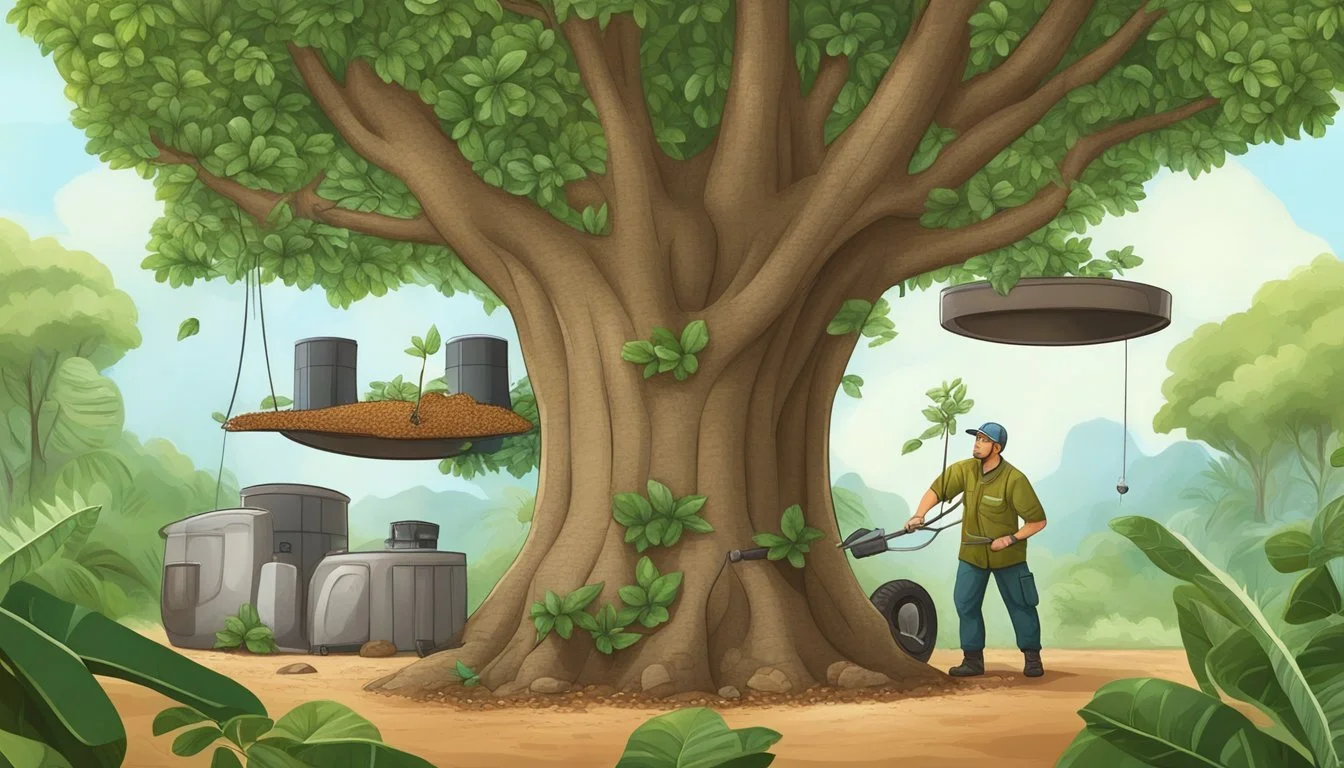Pest Control for Brazil Nut Trees
Effective Management Strategies
The Brazil nut tree, known scientifically as Bertholletia excelsa, is an ecologically significant species native to the Amazon rainforest. Towering above other trees, it plays a pivotal role in the tropical ecosystem and provides a substantial source of income for local communities in Peru, Bolivia, and Brazil. The tree's capacity to produce nutrient-rich nuts (What wine goes well with nuts?) is, however, impacted by a range of pests, making pest control an essential aspect of its cultivation and conservation.
Implementing effective pest control measures for the Brazil nut tree is crucial to sustaining both the health of the Amazonian ecosystems and the economic reliance placed upon these trees. Methods of pest control need to be carefully considered, as they must promote the wellbeing of the tree while minimizing harmful side effects to the surrounding environment. The successful management of these pests not only secures the continued growth of the Brazil nut tree but also ensures the preservation of this tropical marvel for future generations.
Brazil Nut Tree Basics
Understanding the Brazil nut tree basics is crucial for successful cultivation and pest management. Details on the species, characteristics, and growing conditions form the foundation for maintaining tree health and productivity.
Species Overview
The Brazil nut tree, Bertholletia excelsa, is the single species in the genus Bertholletia and is a member of the family Lecythidaceae. It's a towering presence in its native habitat, the Amazon rainforest, and plays a significant role in the ecosystem's ecology.
Tree Characteristics
This tropical evergreen tree is distinguished by its expansive height, often reaching up to 160 feet and a trunk diameter of up to 6 feet. The high canopy only branches out in the upper tier, sporting large, oblong-shaped leaves. The tree has a life span that often extends over 500 years, denoting its resilience and the long-term nature of its cultivation.
Optimal Growing Conditions
For optimal growth, Brazil nut trees require a tropical climate and well-drained soil. They prefer a soil pH that is slightly acidic. Given the tree's significant height, spacing is critical when cultivating these giants. Seedlings need shaded conditions but mature trees thrive in full sunlight, highlighting their adaptation to the rainforest's varying light conditions.
Pollination and Reproduction
The reproductive success of Brazil nut trees hinges on the intricate pollination process, primarily by bees, and subsequent seed development which ensures the perpetuation of the species.
Flowering and Pollinators
Brazil nut trees produce flowers that are reliant on biotic pollination to achieve fertilization. The flowers are typically pollinated by medium to large-sized bees, including genera such as Bombus, Euglossa, Eulaema, and the notably prevalent Xylocopa, known as the carpenter bee. These bees are attracted to the flowers for nectar and pollen—a mutual benefit that facilitates the tree's reproductive process. Unlike many plants, Brazil nut trees are predominantly xenogamous, necessitating cross-pollination between different trees to produce viable seeds.
Fruit and Seed Development
Once pollinated, the Brazil nut tree embarks on fruit development, characteristically producing large, woody capsules containing the seeds. These seeds, commonly referred to as Brazil nuts, require cross-pollination between unrelated trees for optimal viability. Successful seed development is crucial, as it represents the future generation of trees in the natural Amazonian ecosystem where they thrive. The seeds themselves are nutrient-dense, housing the potential to give rise to new Brazil nut trees.
Pest Identification
Identifying the correct pest is crucial for the effective management and treatment of infestations that impact Brazil nut trees. Correct diagnosis ensures appropriate control measures can be undertaken.
Common Pests of Brazil Nut Trees
Brazil nut trees are susceptible to a variety of insect pests. One significant pest is the Brazil Nut Weevil (Conotrachelus spp.), which specifically targets these trees. Other common insect pests include various species of mites and ants that can damage the tree and its nuts. Aphids and spider mites also frequently infest Brazil nut trees, causing a variety of issues from foliage damage to disease transmission.
Signs of Pest Infestations
Observing the trees closely for specific indicators is vital. Signs of infestations include:
Visible insects or mites on leaves or nuts.
Chewed leaves or damaged nuts, often an indicator of the presence of larger insect pests like the Brazil nut weevil.
Sticky residue or sooty mold, which can signal an aphid problem.
Webs on the underside of leaves typically suggest spider mite activity.
Pest Control Strategies
To ensure the health and productivity of Brazil nut trees, employing effective pest control strategies is crucial. These methods range from natural solutions to synthetic chemicals, each playing a role in an integrated pest management approach.
Natural and Biological Controls
Biological control leverages the power of nature to manage pests. Utilizing natural predators and parasites can help keep pest populations in check. For example, introducing or conserving native predator species can reduce the need for chemical interventions. Additionally, the bacterium Bacillus thuringiensis is a biocontrol agent widely recognized for its effectiveness against a variety of insect larvae while being safe for humans and non-target wildlife.
Chemical Control Measures
When natural methods are insufficient, chemical insecticides may be employed. These should be used judiciously to minimize environmental impact and prevent the development of pest resistance. Science has facilitated the synthesis of compounds that target specific pests with minimal side effects, such as those affecting the Brazil nut tree. Periodic applications are often required, but only as a complement to other pest management strategies.
Cultural Practices for Pest Management
Cultural practices encompass the agricultural practices utilized to deter pests. These can include crop rotation, sanitation, and the timing of planting and harvesting. By understanding the biological processes of the Brazil nut tree and its pests, farmers can implement practices that disrupt pest life cycles and reduce their impact on the crop. These practices not only help in managing pests but also promote overall tree health and longevity.
Harvesting and Post-Harvest Handling
Brazil nut trees offer a unique set of challenges and opportunities when it comes to harvesting and post-harvest handling. Utilizing the proper techniques is crucial for maintaining the nut's quality and ensuring safety during processing.
Harvesting Techniques
Harvesting Brazil nuts involves waiting for the fruit, which resembles a large wooden capsule, to naturally fall from the tree. One must never forcefully harvest the fruit from the tree branches, as this can damage the tree and the fruit. Once on the ground, workers typically use a knife or machete to crack open the hard shell of the fruit. Inside, up to two dozen seeds—or Brazil nuts—are tightly packed like segments of an orange. Care must be taken not to damage the shell of the nuts during this process, as it will protect them during storage and transportation.
Nut Processing and Storage
After harvesting, processing Brazil nuts correctly is vital for preserving their quality. Nut production peaks during certain times of the year, and during these periods, it is essential to begin processing as soon as possible to prevent spoilage. The outer husk of each nut is removed, and then they are often roasted to improve shelf life and flavor. Appropriate storage conditions are critical: Brazil nuts should be kept in a cool, dry place to prevent the growth of molds or contaminants. Typically, they are stored in breathable sacks which allow air circulation and prevent moisture accumulation, reducing the risk of aflatoxin contamination—a potential concern with improper nut handling.
Conservation and Sustainability
In managing Brazil nut trees, the focus on conservation and sustainability is fundamental for the longevity of the rainforest ecosystem. Implementing practices that protect the forest while enabling sustainable harvesting is crucial in these efforts.
Sustainable Farming Practices
Agroforestry Systems: These systems play a critical role in sustainable farming in the Amazonian rainforest, particularly for Brazil nut trees. Farmers integrate Brazil nut trees with other crops, providing shade and enriching the forest floor, which is essential for tree health and nut quality. This multifaceted approach helps maintain the natural structure and function of the forest understory and canopy, conserving biodiversity.
Certification and Management: Sustainable practices are reinforced through certifications such as Forest Stewardship Council (FSC) and Rainforest Alliance, which encourage environmentally responsible management of Brazil nut forests. Harvesters are trained to collect nuts without damaging the trees or forest, which promotes the conservation of the area and ensures the longevity of the nut-producing trees.
Ecosystem Conservation
Species Interdependence: The survival of Brazil nut trees is deeply interconnected with the surrounding rainforest ecosystem, relying on specific bee species for pollination that thrive under full forest canopy. Protecting these trees ensures preservation of the unique conditions of the amazonian rainforest that support a wide array of wildlife.
Conservation Efforts: Initiatives such as the Amazon Conservation Association's efforts in conserving Brazil nut forests exemplify how conservation can directly benefit both the environment and the local communities. These programs emphasize the importance of protecting nearly two million acres of rainforest vital for Brazil nut trees while supporting local populations who depend on these ecosystems for their livelihoods.
The intertwining of sustainable practices and ecosystem conservation underscores the importance of a multifaceted approach to managing Brazil nut trees. It demonstrates how the health of these majestic trees is tied to the well-being of the entire forest and its inhabitants.
Nutritional and Economic Importance
The Brazil nuts are renowned for their remarkable nutritional value and their significant impact on the economy of producing countries. Here we explore the health benefits of these nuts and their role in global trade.
Health Benefits of Brazil Nuts
Brazil nuts are a powerhouse of nutrition, providing essential proteins, healthy fats, and vital carbohydrates. They are particularly noted for their high selenium content, which is crucial for various bodily functions including immune system support and antioxidant defense. A single Brazil nut can contain a significant percentage of the recommended daily selenium intake, making them an efficient dietary supplement for this mineral.
Additionally, Brazil nuts offer a range of other important nutrients, including magnesium, phosphorus, and zinc. These nutrients contribute to bone health, energy production, and overall metabolic health.
Brazil Nuts in Global Trade
Brazil nuts play an important role in the economy of countries within the Amazon basin. They are one of the non-timber forest products (NTFPs) that have significant market value. As a commodity on the international market, Brazil nuts support the livelihoods of thousands of families in producing countries such as Brazil, Bolivia, and Peru.
These nut trees not only contribute to local economies through harvesting and sales but also help in maintaining the ecological balance of the Amazon rainforest, thereby providing an incentive for sustainable forestry practices. The global demand for Brazil nuts is a testament to their stable position in the market, thus underlining their economic relevance in addition to their nutritional value.
Frequently Asked Questions
In this section, we address common inquiries regarding pest management in Brazil nut trees, focusing on sustainable practices, historical issues, and the influence of environmental changes.
How can I manage pests on Brazil nut trees without using chemical pesticides?
One can manage pests in Brazil nut trees by employing integrated pest management strategies such as using beneficial insects, fostering natural predators, and implementing cultural practices like crop rotation and sanitation.
What caused the ban on Brazil nuts, and does it relate to pest control issues?
Brazil nuts faced a ban due to concerns over high levels of aflatoxins, which are toxic compounds produced by certain molds. It's indirectly related to pest control, as pest infestations can exacerbate mold growth by creating entry points for pathogens.
Which natural predators pose a threat to the health of Brazil nut trees?
Natural predators that threaten Brazil nut trees include insects like the Helopeltis antonii, which can directly damage the nuts, and various rodents that feed on the seeds.
What are the common diseases affecting Brazil nut trees and their pest control implications?
Common diseases affecting Brazil nut trees include South American leaf blight and various fungal infections, which weaken the trees and make them more susceptible to pest infestations, highlighting the need for integrated disease and pest control methods.
Can organic pest control methods be effective for Brazil nut tree cultivation?
Organic pest control methods, such as the use of bacteriological insecticides like Bacillus thuringiensis and botanical pesticides like neem oil, have shown effectiveness for Brazil nut tree cultivation and can be essential components of a comprehensive pest management strategy.
How does climate change impact pest control strategies for Brazil nut trees?
Climate change alters the lifecycle and distribution of pests, potentially leading to increased pest pressures. Adjusting pest control strategies to account for these changes is crucial for the sustainable cultivation of Brazil nut trees.








